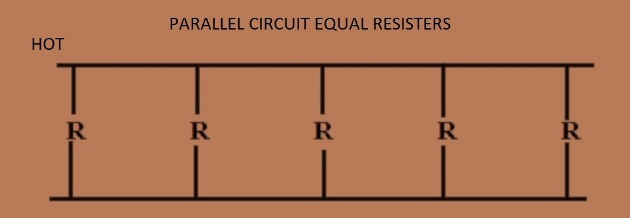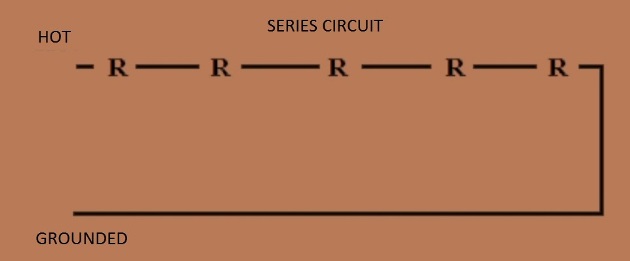
Electrical Terms Definitions
Be certain to also read the article ‘ELECTRICITY, WHAT IS IT?‘ where some electrical terms are explained in a very different way
Definitions
In the articles on this website…
In layman’s terms we usually refer to electrical wiring as having a hot wire, a neutral wire, and a ground.
Ungrounded conductor in layman’s terms is the hot conductor. Ungrounded in that is does not cross earth ground until passing through an item using electrical power such as a light fixture, appliance and so on, so that wire is ungrounded as such and the most dangerous to work with if the circuit is live, as anything touching it could be used as a passage way to the return path including yourself. I will get more into the dangers of working with electricity in the electrical safety and electrical dangers articles on this website.
Also electricians who want to be highly technical, or technically correct in the language may refer to ungrounded conductor (hot) in the switch portion of the circuit as the ungrounded conductor leg (hot), or switched ungrounded conductor (hot).
Grounded conductor in layman’s terms is the neutral. By true technical definition a neutral serves two ungrounded conductors.
The layman term ground is technically an equipment grounding conductor an extra measure of safety built into modern wiring.
Bellow is a more detailed definitions list originally written by my long time partner (Warren Goodrich) in making previous self help websites, unfortunately he is now deceased, but I do not think I could write it any other way, his knowledge and expertise would be hard to come by after all he served as an electrical and building inspector for many years as well as a renowned teacher on this subject.
Definitions and Symbols
AMPS = 746 watts times horse power and then divided by volts.
C = Roman numeral for one hundred.
CM = Circular mill which is the cross sectional area of a conductor.
D = Distance which is the amount of length from the power source and in some calculations plus the amount of length for the return path combined.
E = Volts.
EMF = electromotive force or [voltage].
ETC. = “and so on , and so on”.
Ground = A loose terminology that could be referring to either grounding or grounded.
Grounded = neutral conductors which are normally current carrying conductors.
Grounding = Bonding ground conductors or earth ground conductors.
GFCI = “Ground Fault Circuit Interrupter”. A device that in generic terms monitors the hot conductor, the grounded conductor, and the grounding conductor. The device monitors the electrical circuit that it is to protect for a leakage between these lines with a limit of a maximum leakage of 5 milliamps, or .005 of one amp.
In generic terms the GFCI was discovered, and utilized in our wiring method to protect accidental loss of life, due to shock hazards.
The GFCI has been very successful by all available statistics at saving many lives since it’s conception and use began. When “us”old folks? were kids, and if a radio dropped in our bathtub while we were in it, we most likely were dead! Now with the GFCI protection device we might have a half a chance at survival. A GFCI is so sensitive that a leakage of .005 of one amp between the grounded conductor and hot conductor, or between the hot conductor and the grounding conductor, or even between the grounded conductor {white} and the grounding conductor {green} is designed to kick out the device, and de-energize the circuit that GFCI is to protect.
Horsepower = a measurement of mechanical power that a motor produces. In electrical, one horse power equals 746 watts. In mechanical terms one horse power is produced when 33,000 pounds are lifted one foot in one minute. Horse power represents the work being done by the output of an electric or internal combustion style motor.
Hot = A current carrying conductor with voltage present.
I = Load in amperes which is the resistance multiplied by the voltage.
Input = What you pay for
Input = In another term input can be a Primary of a transformer
K = Short for kilo in Greek meaning/one thousand. Remember this term for electrical terminology. Example kilowatt / KVA / “K”= a terminology of conductor resistance which is the resistance of a conductor multiplied by the circular mill and then divided by one thousand, normally found in a voltage drop calculation.
Kilowatt = Units of watts in calculation of one thousand.
M = Roman numeral for one thousand. Not normally found in electrical terminology.
Megawatt = units of watts in calculation of one million.
Neutral = The return path of a circuit carrying only the unbalanced load of two ungrounded conductors. A neutral may not be broken by a switch or other type of device. A neutral will be referred to as a grounded conductor.
Ohms = A measurement of resistance. The resistance through which one volt will force one ampere.
Output = Work performed
In another term output can be a Primary of a transformer
Parallel Circuit = Where the current divides, and therefore has more than one path to flow, their total resistance is the sum of individual currents. The voltage across each of the loads are the same. The total resistance is less than any individual resistor. In a parallel circuit, you can remove one resistance [light bulb etc.] without affecting the work performance of any of the other resistance [light bulb etc.] on that parallel circuit.

PF = Power factor which is the ratio between the power in watts, and the apparent power in volt-amps. Power factor is normally expressed in percentages.
R = Resistance which is the opposition that a device, or material offers to the flow of current. The opposition which results in the production of heat in the material carrying the current. Resistance is measured in ohms. All resistance have two dimensions. Cross sectional area, and length.
Series Circuit = Where the current flow is the same. The total resistance equals the sum of the individual resistance. In a series circuit you can not remove one resistance [light bulb etc.] on that series circuit. [The circuit will de-energize unless you replace the connected void created by the removal of that resistance, {light bulb etc.}].

V = Volts which is a nominal value assigned to a circuit or system for the purpose of conventionally designating it’s voltage class. The pressure required to force one ampere through a resistance of one ohm.
VA = Volt amps which is the electric current that will flow through one ohm under the pressure of an applied voltage.
VD = Waste of electricity due to the heating of a conductor.
Voltage drop which is the amount of voltage reduced due to the resistance and length and load of a wire used.
VD = The load applied to a conductor multiplied by the resistance created by that conductor.
W = Watts, which is a unit of electrical power of the rate that a form of energy [work performed]. A unit measure of power.
Ungrounded = Hot Conductor.
Volt Amperes = Watts divided by the power factor.
If carefully said, and in general (Layman’s) terms, volt amperes and watts are generally the same, unless dealing with electronics. VA = W or watts divided by power factor.
PF
Watts = W = VA x PF or volt amperes multiplied by the power factor
If carefully said, and in general (Layman’s) terms,
volt-amperes and watts are generally the same, unless dealing with electronics.
WHILE EXTREME CARE HAS BEEN IMPLEMENTED IN THE PREPARATION OF THIS SELF-HELP DOCUMENT, THE AUTHOR AND/OR PROVIDERS OF THIS DOCUMENT ASSUMES NO RESPONSIBILITY FOR ERRORS OR OMISSIONS, NOR IS ANY LIABILITY ASSUMED FROM THE USE OF THE INFORMATION, CONTAINED IN THIS DOCUMENT, BY THE AUTHOR and / OR PROVIDER.
Originally Written By: Warren Goodrich